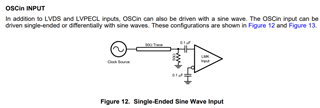Tool/software:
Hi,
I'll be driving LMK01010 directly with my XO with limited current capability and it'll also have to drive another load (~400 ohm) in parallel, so I cannot spare much current to drive the LMK01010.
There is information in the datasheet on driving the part with an AC coupled sinewave. Can you please provide some information on how to drive the clock input with LVCMOS 3.3V?
Thanks,
Christer




